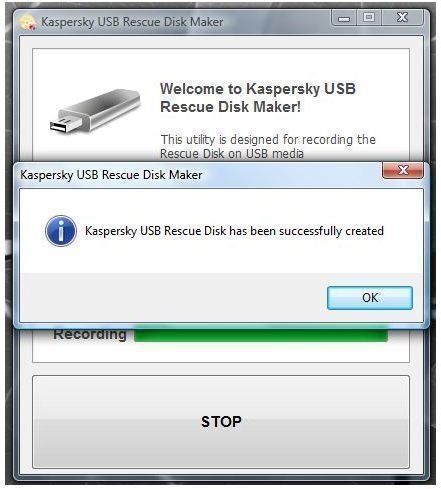

- #Kaspersky rescue disk boot usb database update malfunction serial
- #Kaspersky rescue disk boot usb database update malfunction driver
- #Kaspersky rescue disk boot usb database update malfunction manual
- #Kaspersky rescue disk boot usb database update malfunction iso
- #Kaspersky rescue disk boot usb database update malfunction download
Nodmraid - Disables support for device-mapper RAID, such as that used for on-board IDE/SATA RAID controllers. This is useful on networks with only static addresses. Nodhcp - This disables DHCP probing on detected network cards. This is useful for doing debugging of a failing CD or driver. Nodetect - This disables all of the autodetection done by the CD, including device autodetection and DHCP probing. It has been known to cause some problems on older hardware. Noapic - This disables the Advanced Programmable Interrupt Controller that is present on newer motherboards. This also disables the default hdparm settings from being executed. If your system is having trouble reading from your IDE CDROM, try this option. Ide=nodma - This forces the disabling of DMA in the kernel and is required by some IDE chipsets and also by some CDROM drives. Replace hda with the device that is requiring this option. This option is only used on machines with an older BIOS.

Hda=stroke - This allows you to partition the whole hard disk even when your BIOS is unable to handle large disks. This is also a requirement for booting most USB devices, as they use the SCSI subsystem of the kernel. This is only required when booting from a PCMCIA/Cardbus device.ĭoscsi - This loads support for most SCSI controllers. This requires you to also use acpi=off.ĭobladecenter - This adds some extra pauses into the boot process for the slow USB CDROM of the IBM BladeCenter.ĭopcmcia - This loads support for PCMCIA and Cardbus hardware and also causes the pcmcia cardmgr to be started by the CD on boot.
#Kaspersky rescue disk boot usb database update malfunction driver
Options should be encapsulated in quotes.ĭoapm - This loads APM driver support. The default options are 9600,8,n,1.ĭmraid=X - This allows for passing options to the device-mapper RAID subsystem. The first option is the device, usually ttyS0 on x86, followed by any connection options, which are comma separated.
#Kaspersky rescue disk boot usb database update malfunction serial
This will disable any Hyperthreading support of your processor.Ĭonsole=X - This sets up serial console access for the CD. This is useful on some older systems, and is also a requirement for using APM. This is not required for Hyperthreading support.Īcpi=off - Completely disables ACPI. This is only needed if your system requires ACPI to function properly. Easily remove malicious objects from your computer without the risk ofĪcpi=on - This loads support for ACPI and also causes the acpid daemon to be started by the CD on boot. For example, "doscsi" enables SCSI support in the initial ramdisk boot, while "noscsi" disables it. This lists the Gentoo-specific options, along with a few options that are built-in to the kernel, but that have been proven very useful to our users.Īlso, all options that start with "do" have a "no" inverse, that does the opposite.
#Kaspersky rescue disk boot usb database update malfunction iso
It replaces the current files and definitions with the updated ones and creates two updated iso images in the end.Boot from the Kaspersky Rescue Disk to scan and remove threats from an infected computer without the risk of infecting other files or computers.īurn this ISO image to a CD, insert it into the infected system's CD-ROM drive, enter the PC's BIOS, set it to boot from the CD and reboot the computer.
#Kaspersky rescue disk boot usb database update malfunction download
The batch file extracts the contents of the ISO image and starts to download the latest virus definition files from a Kaspersky server. Rename the iso image to rescue.iso and start the diskupdt.bat file afterwards. Copy the ISO image in to the Rescue Disk Updater directory. Here is how it works. Download the Rescue Disk Updater file from Github and make sure you also have the latest available version of the Kaspersky Rescue Disk at hand (you need the ISO). It works best if you have copied the Rescue Disk to an USB drive as you can update the files stored on that drive easily. The Kaspersky Rescue Disk Updater helps you automate the process to a certain degree. Plus, downloading the whole ISO image every time wastes a lot of bandwidth as you will not only download updated files but also all other files that have not been updated in the meantime.
#Kaspersky rescue disk boot usb database update malfunction manual
While you can download the ISO image regularly and repeat the process, it is not really something that is well suited as a manual task. One of the issues here is that the rescue disk becomes less useful with age as the program itself and the included virus definition database are not updated automatically. Once done, you'd boot from the device or disc whenever you need to. The tool is provided as an ISO image that you need to burn to disc or copy to an USB Flash Drive to make use of it.


 0 kommentar(er)
0 kommentar(er)
